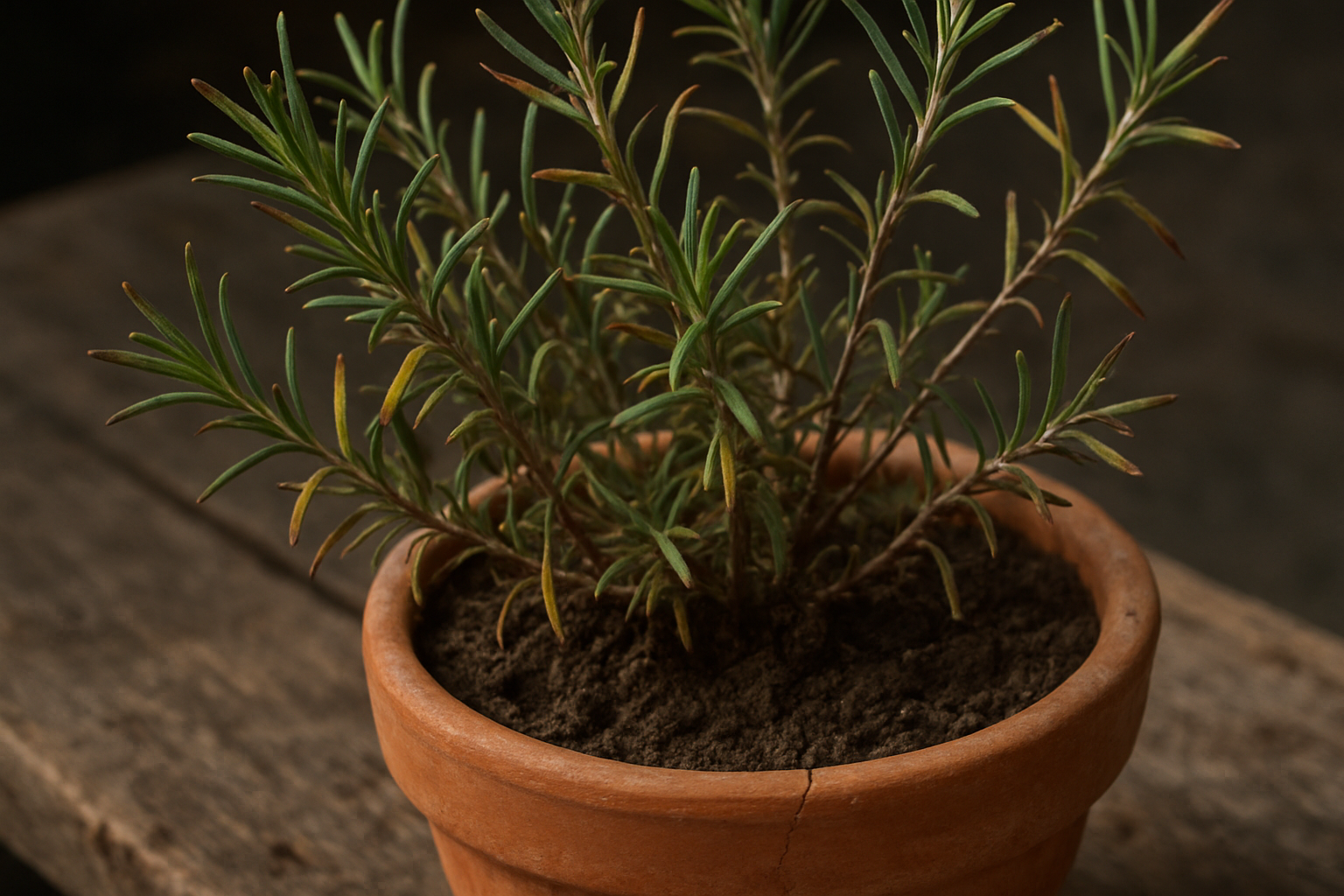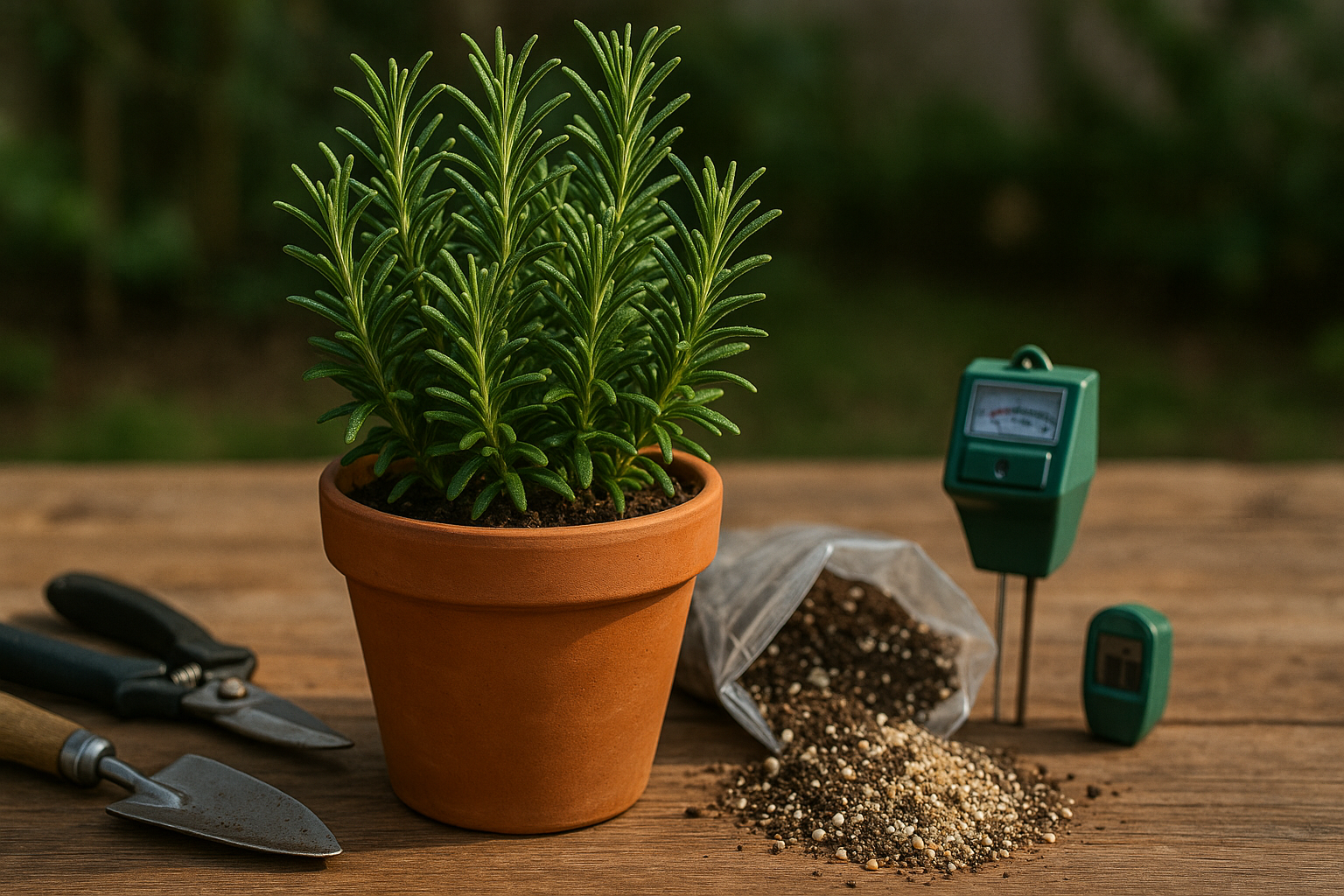Common Signs Your Rosemary Plant Is Struggling

Spotting trouble early is key to saving your rosemary plant, and most issues start with subtle changes in its appearance or growth. If you notice yellowing leaves, especially starting at the base, this often signals overwatering, poor drainage, or the beginning of root rot. Browning leaf tips or crispy edges can result from underwatering, excessive heat, or fertilizer burn—so check if the soil is bone dry or if you’ve recently fed your plant.
Leaf drop is another telltale sign. A healthy rosemary holds onto its needle-like leaves, so sudden shedding usually means the plant is under significant stress from drastic environmental changes, pests, or serious disease. Stunted or leggy growth, where your rosemary looks sparse or isn’t filling out well, may indicate insufficient light, old soil, or a rootbound condition in potted plants.
The key for web readers is to distinguish minor, recoverable stress—like a few yellow leaves after transplanting, which is quite normal—from persistent, spreading issues. If discoloration and leaf drop worsen daily, or if stems start turning brown and woody, these are red flags that require quick action.
Paying attention to these signs early gives you a much better chance of reviving your plant and preventing minor problems from becoming plant-killing issues. In the next section, we’ll walk through practical troubleshooting steps so you can identify what’s wrong and bring your rosemary back to vibrant health.
Root and Watering Problems

When rosemary starts to decline, root and watering issues are often to blame, with overwatering and underwatering being the main culprits. Overwatering leads to soggy soil, which suffocates the roots and encourages root rot. Signs include yellowing leaves, soft or mushy stems at the base, and a generally droopy appearance. In severe cases, the plant may emit a foul odor from rotting roots.
Underwatering, on the other hand, causes rosemary to look wilted, dry, and brittle. The leaves may feel crispy, the soil pulls away from the pot edges, and new growth is stunted or nonexistent.
If you suspect watering issues, check your plant’s habits by sticking your finger about an inch into the soil. If it feels wet or cold, wait before watering again. To assess root health, gently remove the plant from its pot and inspect the roots—healthy roots will be white or light tan and firm. Brown, black, or slimy roots indicate rot.
To water rosemary correctly, let the top inch of soil dry out before thoroughly watering, making sure excess water drains freely from the bottom. Use well-draining soil mixed with sand or perlite, and always plant rosemary in a pot or garden bed with drainage holes.
In hot weather, rosemary needs regular but moderate watering—don’t let the soil dry out completely, but avoid soaking wet conditions. Always empty saucers beneath pots to prevent waterlogging. Adjust watering frequency with the seasons, as rosemary requires less water during cooler months.
If you’ve overwatered, allow the soil to dry out and trim damaged roots before repotting. For underwatered plants, soak the pot in a basin for 15–20 minutes to rehydrate the soil, then return to your regular watering schedule.
Getting this balance right is key: rosemary thrives on a “less is more” approach to watering and will reward you with healthy growth if you pay attention to its subtle cues.
Soil, Drainage, and pH Issues
Growing healthy rosemary starts with mimicking its native Mediterranean environment: light, well-draining soil is a must. Rosemary roots are sensitive to overly wet or compacted soil—excess moisture leads to root rot, fungal disease, and eventual plant failure. If your garden soil tends to hold water or feels sticky after rain, it may be too heavy for rosemary to thrive.
The ideal solution is to blend coarse sand, fine gravel, or perlite into your soil to increase drainage and prevent root suffocation. If space allows, planting in raised beds or large pots with drainage holes further helps reduce waterlogging.
Alongside drainage, pH also matters: rosemary flourishes in neutral to slightly acidic soil, ideally between 6.0 and 7.0. If your soil is too acidic (below 6), the plant struggles to absorb nutrients, resulting in yellowing leaves and stunted growth. On the flip side, overly alkaline soil (above 7) can block trace minerals, causing dull foliage and poor aroma.
To test your soil’s pH, use an inexpensive at-home kit from the garden center. If adjustments are needed, add garden lime to raise pH or elemental sulfur to lower it, following package directions.
For container-grown rosemary that’s languishing, unpot the plant and inspect the root ball. If the roots are tightly wound or brown and mushy, trim away damaged sections and repot in a fresh, gritty mix—try blending two parts potting soil with one part perlite and one part coarse sand. Place the pot in a sunny location and water only when the top inch feels dry.
These simple adjustments make a dramatic difference, transforming struggling rosemary into a hearty, fragrant herb patch—and keeping it healthy for seasons to come.
Environmental Stress Factors
Plants are highly sensitive to environmental stress factors, and recognizing the signs early can make a big difference in their health. Temperature extremes are a common culprit: frost can cause leaves to turn black, wilt, or look water-soaked, while heatwaves may lead to scorched, brown-edged foliage and wilting as the plant struggles to conserve moisture.
High humidity, although beneficial for some species, can encourage fungal diseases—watch for yellowing leaves, moldy patches, or a damp, musty smell. On the other hand, insufficient sunlight results in leggy growth, pale leaves, and poor flowering as the plant stretches towards available light.
To help your plants thrive, aim for consistent growing conditions—most garden plants prefer temperatures between 65°F and 75°F, moderate humidity, and at least 6 hours of indirect sunlight daily. Creating a microclimate can buffer against extremes:
- Plant sensitive varieties in sheltered spots near fences, walls, or hedges to shield from wind and frost.
- Use row covers or cloches on cold nights.
Indoors, adjust placement based on the season—move sun-loving plants to south-facing windows in winter, or provide supplemental grow lights if natural sunlight is lacking.
Good air circulation is another key factor; avoid overcrowding by providing enough space between plants and occasionally rotating pots to ensure even exposure to light and airflow. Poor air movement or cramped conditions can trap heat and moisture, exacerbating stress from temperature and humidity, and encouraging pests and diseases.
By understanding and managing these stressors, you can create an environment where your plants are more resilient, grow vigorously, and reward you with lush, healthy growth.
Pests and Diseases
Keeping rosemary thriving means staying vigilant against a handful of common pests and diseases. Aphids and spider mites are frequent culprits—look out for clusters of tiny green, white, or black bugs (aphids) on new growth, or fine webbing and yellow, stippled leaves (spider mites) that indicate their presence.
Diseases can sneak in, too: root rot, usually caused by overwatering or poor drainage, shows up as yellowing leaves and limp stems, while powdery mildew looks like a white, fuzzy coating on the leaves, especially in humid or crowded conditions.
For natural pest control, a simple spray of water can dislodge aphids, and introducing beneficial bugs like ladybugs can help keep their populations in check. Neem oil or insecticidal soap are safe and effective for both aphids and mites—just remember to spray early in the morning to avoid leaf burn.
For diseases, prevention starts with planting rosemary in well-draining soil and pots with drainage holes, and watering only when the soil is dry to the touch to prevent root rot. If you spot infected stems or leaves, prune them away immediately and dispose of them in the trash.
Good air circulation is vital: space your rosemary plants well, prune regularly to keep the centers open, and avoid overhead watering that can promote leaf diseases. A little attention goes a long way—by watching for early warning signs and opting for gentle, organic solutions, you’ll keep your rosemary healthy, fragrant, and ready for your favorite recipes.
Pruning and Maintenance Mistakes
Pruning is essential to keep your rosemary plant healthy, bushy, and thriving for years. Proper trimming encourages new growth, prevents the plant from becoming woody and sparse, and helps maintain a manageable size for harvesting or decorative use.
However, several common mistakes can jeopardize its health. One frequent error is cutting too deeply into old, woody stems—rosemary rarely regrows from this hard, brown base, so always focus your cuts on the softer, green shoots. Neglecting to prune at all can also cause plants to get leggy and less productive, while overenthusiastic trimming—removing too much foliage at once—can stress or even kill your rosemary.
To get it right, always use clean, sharp shears and avoid removing more than one-third of the plant at a time. The best time to prune is in early spring as new growth begins, with a light trim again in midsummer to shape the plant. Avoid heavy pruning in late fall, which can leave your plant vulnerable to winter damage.
As a simple schedule, aim for a thorough trim in March or April and a light shaping in July. Regular, gentle pruning keeps your rosemary lush, aromatic, and ready for both the garden and the kitchen.
Quick-Action Rescue Plan
If your rosemary looks sad or is losing leaves, don’t panic—there’s a simple rescue plan to help it bounce back. First, check the soil: rosemary hates soggy roots, so let the top inch of soil dry out before watering. If the pot feels heavy or the soil stays damp for days, repot your plant using a well-draining mix designed for Mediterranean herbs. Always make sure the container has drainage holes.
Next, tackle pruning: trim away any brown, dried, or mushy stems but leave healthy green growth, as this encourages new shoots. If your rosemary is indoors or in partial shade, try moving it to a spot that gets at least 6-8 hours of direct sunlight—south-facing windows or bright patios work best.
For ongoing care, avoid over-fertilizing; rosemary thrives on neglect, needing just an occasional feed during the growing season and protection from extreme cold. Stick to a consistent watering routine and rotate the pot weekly so all sides get even sun.
Remember, even stressed rosemary can recover quickly with the right TLC—most bounce back within a month if you address issues early. Keep an eye out for new growth and don’t be discouraged by some initial leaf loss; resilience is in rosemary’s nature. With a bit of patience, you can enjoy a fragrant, thriving plant for years to come.
